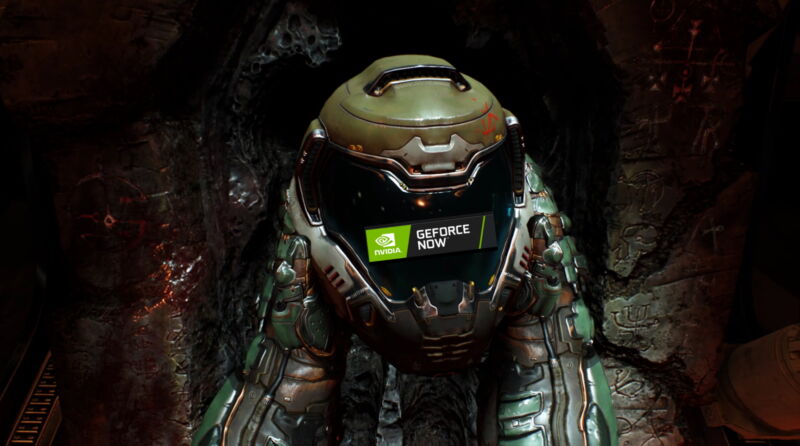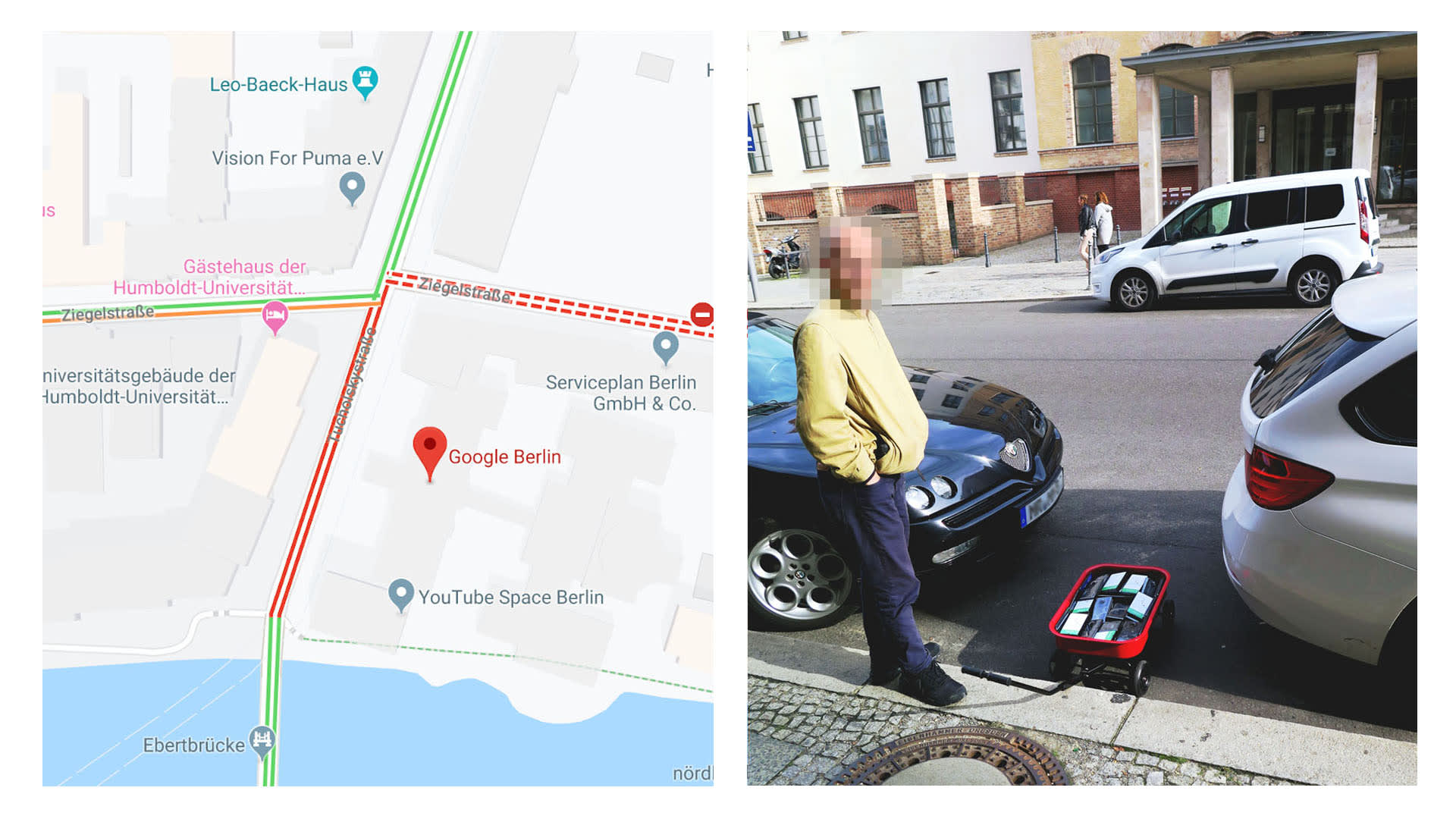https://arstechnica.com/?p=1650656

Imagine it: a video game streaming service that lets you log on to the cloud, access games you already own on multiple storefronts (including free-to-play fare), and play them on any Windows, Mac, or Android device. You’d need nothing more than a broadband connection. You’d get snappy, low-latency performance, including tolerable stats on your router’s 5Ghz wireless band. And you could access all of this for free.
All of this was what we had hoped to get out of Google Stadia, which arrived in November with promises of a tantalizing “Netflix for games” model. But that streaming service’s launch was immediately hobbled with device restrictions, pricing confusion, and a terribly limited (and closed) games library. Instead, the above description comes courtesy of an utter surprise, launching today in both free and paid tiers: Nvidia’s GeForce Now.
After a months-long closed beta, GeForce Now opens to the public sometime today (perhaps the moment this article goes live). Download its app on a supported device, then hook up your preferred control method (gamepad, mouse+keyboard) and connect to one of Nvidia’s servers. You’ll boot into a virtualized Windows PC on the cloud, which then loads one of “hundreds” of supported games as sold by Steam, Epic Games Store, Battle.net, uPlay, the Bethesda Launcher, and Origin. From there, the server’s gameplay feed and your button presses go back and forth so that your low-powered device can stream high-end 3D video games.
DOOM 2016 on a low-end Macbook? Tekken 7 on a smartphone? With enough bandwidth, GeForce Now can make it happen, and you can use the game licenses you already own.
The service isn’t perfect—with some particularly baffling issues at launch. And I fear that its first-week rush of new free players will lead to networking nightmares and boilerplate replies about Nvidia “being surprised by demand.” (If Nvidia’s PR team would like, I have 4,000 versions of that sentence littering my games-journalism inbox. You can borrow any of them.) But ahead of today’s influx of new players, I was able to confirm enough about peak performance and general usability to confirm a surprising truth: even if Nvidia fumbles the launch with networking woes, GeForce Now is still the new game-streaming service to beat. It’s that good.
So far, so solid
-
There’s plenty of blur to account for in DOOM 2016. Here’s an example of how that can look in action, as taken from real-time GeForce Now gameplay.
-
An early vista in the DOOM 2016 campaign. Notice the FPS counter at the top-right? That’s with all settings cranked to maximum at 1080p rendering resolution. You’ll only see 60fps on a GeForce Now stream, but the added frames don’t introduce local tearing.
-
More DOOM motion blur.
-
When GeForce Now performs at its best, mid-animation screens like this one from Tekken 7 look a lot crisper than you might expect.
-
Since this is logging in to my existing Steam account, GeForce Now recognizes which Tekken 7 DLC I own (and don’t own). Negan, you’re not balanced, but I love ya, anyway.
-
They’re not exciting screens, but they are all taken from my Windows 10 machine running GeForce Now’s 1080p feed.
-
Pretty sharp stuff as a streamed game, Sonic Mania.
-
Best of all, we can capture benchmarks, like this Wolfenstein Youngblood test. This is with all settings maxed out and demanding ray tracing features enabled.
-
Civilization VI benchmarks: CPU version.
-
Civilization VI benchmarks: GPU version.
-
But here’s the tricky thing: You never know what kind of virtual machine performance you’re going to get. This is an Assassin’s Creed Odyssey benchmark run at its default medium-ish settings.
-
And here’s another AC: Odyssey benchmark, only as you can see here, it’s set to the “ultra-high” preset and achives a 61fps average. This instance was powered with 3.5GB of VRAM, as opposed to the other instance’s 2GB.
Here’s what I loved about my pre-release tests of GeForce Now: I could play games I already own on my crappiest devices with incredible performance results. While connected via Ethernet on my home-office connection, rated for 250Mbps down, 10Mbps up, I enjoyed nearly latency-free performance on a majority of my tested games. Fortnite, Apex Legends, Destiny 2, and the 2019 remake of Modern Warfare: I played these on mouse and keyboard via GeForce Now and barely noticed their inherent latency.
Yes, I’m as stunned as you are. And if you don’t believe me, you won’t want to see the following sentence: I could play the sensational 2017 retro throwback Sonic Mania via GeForce Now without missing a single jump or dash.
What’s more, I can go into every supported game’s settings menus and tinker to my heart’s content, because GeForce Now effectively leases a Windows gaming PC to each of its users. I’m not accessing a game’s limited build with a missing options menu. Fine-tuned settings like ambient occlusion, shadow resolution, even v-sync and super-sampling: they’re all mine to tweak. This became starkly clear when I loaded
, a notoriously demanding game from 2018 that, up until this week, hadn’t received a 60fps option on anything other than locally owned computers.
You cannot run AC:O at 60fps on Google Stadia. Nvidia’s GeForce Now, on the other hand, let me downgrade and massage the game’s settings to not only reach a 60fps threshold but test it with the game’s built-in benchmark (only available on PC). The same tweak-for-60fps awesomeness goes for other PC games on GeForce Now that console owners are stuck playing at 30fps, including Destiny 2 and No Man’s Sky.
To be clear, I am not suggesting that GeForce Now’s streamed gameplay looks better or runs faster than a powerful PC in your own home. But during my clearest tests, the results were an incredible substitute for owning a gaming-caliber PC.
A future paid tier: More RTX, fewer timers
I have more praise to offer, but I should get some criticisms out of the way. I don’t want to mislead anyone about GeForce Now’s launch-day state. Some of the issues are mere road bumps. Others count as potential red flags.
Let’s start by clarifying the cost situation for GeForce Now, because its “free” sales pitch comes with some asterisks. Nvidia’s streaming service will eventually operate with a mix of free and paid memberships. While Google Stadia also has a “free versus paid” dichotomy, Nvidia’s model differs significantly.
-
A handy infographic about GeForce Now.
Nvidia
-
Notice what’s missing in this supported-device rubric: iOS. Even Chromebooks have an estimated time window listed here; Nvidia had nothing to say about iOS estimates, on the other hand.
At launch, anyone can join GeForce Now’s “founders tier,” which will be free to all interested users for the first 90 days, no credit card required. Once that trial runs out, users can lock in a $5/month rate for their first year. Nvidia representatives say that this rate will increase at some point in the future. “I wouldn’t expect [the raise] to be more than double,” GeForce Now GM and VP Phil Eisler told Ars Technica in a phone interview.
Unlike Stadia, GeForce Now’s “premium” membership does not affect general streaming performance, and it doesn’t (currently) come with any bonus games. Whether you’re on the free or paid tier, you’ll receive the same maximum streaming feed of 1080p resolution at 60 frames per second. Instead, premium users will get to skip one possible headache on the free tier: server queue times. Free users will be bumped to the back of the queue line, while paying members skip ahead.
What’s more, free users will get punted from GeForce Now every 60 minutes. Those free players can log back on for as many one-hour sessions as they want, Nvidia has confirmed, with the caveat that they might have to wait in a queue whenever they return. “This has to do with our promise to founders members, that they won’t have to wait,” Eisler said. “The busiest time is in prime time, at 8pm in the evening. We need a way to ensure that free members don’t jump on at 3pm and camp on the capacity.” Eisler didn’t clarify how the general userbase will be affected by this for the first 90 days, when every user will have identical free-trial memberships.
The other perk of GeForce Now premium membership is access to RTX graphics toggles in supported games. At launch, GeForce Now supports only three games in RTX mode: Metro Exodus, Deliver Us The Moon, and Wolfenstein Youngblood. In good news, at least, these games can all have their settings cranked to maximum on GeForce Now (including “high” or “maximum” settings on demanding ray tracing toggles) and run at average rates exceeding 60fps, at least according to our cursory benchmarks over this past weekend. Boot these games via GeForce Now in the free tier, on the other hand, and they’ll be loaded on a server without RTX support—and thus won’t have any RTX-specific toggles in their options menus.
Good news on storefronts; bad news on reaching them
But wait, you might say to yourself. Aren’t there more than three PC games from the past year-plus that support DirectX 12 ray tracing that Nvidia has loudly advertised as reasons to buy one of their fancy RTX graphics cards? You’d be correct. But many of those, including Ars’ 2019 Game of the Year Control, cannot currently boot on GeForce Now.
No RTX review here
Until GeForce Now bolsters its library of games with ray tracing support, we’re not going to spend time reviewing the pros and cons of RTX elements in streamed games. We’ve talked about ray tracing in the past, and it can look incredible in compatible games, so a $5/mo subscription option seems easier to test than a $400-and-up graphics card. For now, at least, GeForce Now’s superb handling of blocky color artifacts and black crush bode well for future RTX-loaded games on the service.
This is where GeForce Now’s patchy games library comes into bright relief. The great news is that Nvidia has concluded something that upstart services like Stadia have failed to appreciate: gamers don’t want another freaking marketplace.
“We do not have a PC games store,” Eisler said. “Gamers told us strongly that they prefer to connect to their existing PC stores. We’ll support any and all PC stores. Connect to your existing online PC game store accounts. If you purchase a new game, you own it on that platform, and you can download it on your PC later. And we’ll support free-to-play games.”
I love this idea, Nvidia, and I wholeheartedly support it. But I can’t say the same about the current execution.
For starters, GeForce Now doesn’t work as a clone of your existing game-purchase libraries. As I mentioned earlier, GeForce Now can log in to Steam, Epic Games Store, EA Origin, Ubisoft uPlay, and Blizzard Battle.net. Other services are not currently compatible. Even with this storefront limitation, you don’t boot into one of Nvidia’s cloud instances and browse through those apps’ libraries. You can only select games within GeForce Now’s app.
-
Let’s dig into the weirdness of GeForce Now’s interface on Windows, which starts with occasional failures to boot games due to… well, I don’t know, in this case. I could quit and reboot a few times to get into a session when this endless-waiting issue came up. I hope more specific error guidance will appear for players once servers start filling up.
-
Upon booting the app for your first time, you’ll have to wait for the app to analyze your network environment.
-
Sometimes, when you pick a game in the PC client, you’ll be shown the PC Steam client while you wait for the game to boot. When you load Steam games on smartphones or TV devices, you’ll instead see the Steam Big Picture interface.
-
Each virtual Windows instance must grab and install apps upon each boot, which it admittedly does incredibly quickly. Sometimes, you have to tap to confirm the download; most of the time, it does this part automatically.
-
In one instance, however, GeForce Now’s virtual instance tried to stream from the very computer I was running my tests on. No, GeForce Now. Don’t double-stream me.
-
But in good news, I could run benchmarks!
-
Weird error messages filled my screen after quitting a session of Fortnite.
-
Want to try and boot games that aren’t listed in the GeForce Now app? You can try to do so by booting directly into Steam.
-
However, this mostly results in error messages like the one above. It takes a lot of hunting to find supported titles that aren’t already exposed by Nvidia’s front-end software.
More specifically, you tell GeForce Now which game you want to play, and it will load a virtualized PC environment with that game’s launch code (i.e. “C:\\Steam\Steam.exe -your_game.exe -shutdown-upon-app-closure” or something). Though you’ll be within a familiar PC game launcher interface, any attempts to boot other games you own in that instance will bring up error messages, saying the games aren’t supported. (As the above gallery shows, there’s also an inherent awkwardness of being shown various Steam and EGS prompts when trying to load a game, as opposed to the elegance of competitors’ games “just loading.”)
Worse, GeForce Now has no interest in simplifying the process of finding your compatible games. As of press time, you’re required to manually search within Nvidia’s app for every game you own, then add it to the GeForce Now app’s “library” tab. Nvidia has yet to publish a comprehensive list of supported games for the service’s public launch. Worse, the service used to share a comprehensive list, but that’s been taken down as of press time.
As a result, this weekend, I spent half an hour manually typing in every game I own across all five services, and additional games I don’t, just to determine what I could test. And to top off that madness, the service comes with a weird exception: certain Steam games will work in GeForce Now, despite not appearing in the GeForce Now app. But to figure out which games those are, you have to—I’m not making this up—boot into GeForce Now’s Steam instance, then manually double-click on every game you own to see if there are any loopholes that you can sneak onto the cloud service. Doing this mostly brought up error messages for me, with the exception of oddball fare like Metal Wolf Chaos XD.
No thanks. I’ll just wait for Nvidia to get its act together and issue a formal list like every other gaming-service retailer in existence.
[Update, 1:17 p.m.: A reader pointed us to a convenient, publicly available JSON file on Nvidia’s site, which can be translated using built-in Firefox tools or a site like JSON Formatter to get a slightly messy, alphabetical list of every game currently supported by GeForce Now. Based on my weekend of testing, this list of 556 games appears to be accurate, though it’s missing the “loophole” games mentioned above. We’d prefer an official Nvidia list, but we’ll use this workaround in the meantime. Thanks, anonymous tipster!]
Is your library compatible? You get to find out!
Perhaps this is to obscure the fact that Nvidia’s compatible game selection is currently scattershot. As one example, the previous full list of compatible GeForce Now software used to list all three games in the modern Tomb Raider trilogy; all three have since been removed, with no clear explanation as to why. Is this because the games’ publisher, Square Enix, has since signed an exclusivity deal with Stadia? When pressed, Nvidia’s representatives forwarded the following statement to Ars Technica:
We work with our partners on an on-going basis to add games to GeForce Now. From time to time, publishers may request that a game be disabled. It can be for various reasons. We can’t go into specific details as to why a publisher may have asked that, but we do encourage GeForce Now members looking for specific games to request that they be added by reaching out to both us and the publisher.
In terms of my personally owned games libraries, GeForce Now supports roughly 140 of the nearly 700 non-VR games in my Steam library. Nearly every game sold by Battle.net works here, with the exception of the newly launched WarCraft III: Reforged, while Ubisoft’s uPlay has a few recent Assassin’s Creed, Far Cry, and Tom Clancy games, but it’s missing quite a few of those. Bethesda and EA currently only appear to have one compatible game for each of those launchers: Fallout 76 and Apex Legends, respectively. (You’ll need the Steam version of all other Bethesda games on GeForce Now, while the lack of mainstream EA biggies like Madden and FIFA is a bummer.)
Epic Games Store works seamlessly on GeForce Now if you want to play Fortnite, which is probably the most crucial game for that launcher, in terms of average-user outreach. But EGS is otherwise pretty badly supported as a launcher on GeForce Now, with only Borderlands 3, Dauntless, and Metro Exodus standing out as recent big-name games with GeForce Now support. (No Untitled Goose Game? To that, I must say: HONK!) Also, as of press time, a number of games that work on both EGS and Steam can only be played via GeForce Now if you own the games’ Steam licenses.
-
Until Nvidia releases a full list of compatible titles, we’re left awkwardly sorting them by hand. Here’s a look at the service’s “featured” tab of compatible games, which are at least an indication of the range you can expect.
-
More of Nvidia’s choices of “featured” games. Remember: You need to own the game on another service before you can boot it on GeForce Now. Neither its free or paid tiers come with free, included games.
-
The last of their early “featured” tab of games. Nvidia says to expect more compatible games in the coming weeks and months. And while we’re here, one other nitpick: You cannot currently sort the service’s “library” interface as you see fit (alphabetical, release date, etc.).
That being said: I am generally happy with the service’s game compatibility list as of its public launch, especially when I imagine someone wanting to use GeForce Now to play solid PC games when they either don’t own a gaming PC or might be away from their favorite rig. Want to play “one more turn” in a Sid Meier classic? Pick from either Civilization V or Civilization VI; they’re both CPU- and GPU-hungry enough to make their GeForce Now inclusion welcome. Want to rip and tear? GeForce Now supports the F2P deathmatches of Quake Champions and the technically impressive campaign of DOOM 2016 (which, curiously, still isn’t available on Stadia in spite of Google’s ballyhooing about that game).
Apples to apples to apples
As of press time, GeForce Now only has a few apples-to-apples comparisons: the current Project xCloud “closed beta” on smartphones and Google Stadia’s “Founders Edition” on desktops. I can load nearly identical scenarios in these two comparisons, and against both of those, GeForce Now has the overall lead.
Currently, xCloud’s closed beta only works on Android smartphones with a maximum resolution of 720p, so I connected an Xbox One controller to my Samsung Galaxy S9 via Bluetooth, then connected that phone to my home’s 5GHz wireless band and booted into sessions of Tekken 7 and Destiny 2. In the former, I loaded identical stages in the game’s offline practice mode and tapped individual attacks. In the latter, I simply puttered around in the character-select screen, which allowed me to move a mouse-like cursor on the screen with the analog joystick.
In both cases, GeForce Now enjoyed a sliver of a lead in terms of latency, one that I was able to verify six tests in a row. In my first of three Tekken tests, the GeForce Now version failed to process a few of my button taps. I couldn’t reproduce the issue in that version’s other tests, so I offer it as an anecdotal note—especially since wireless tests include so many connectivity variables.
To that end, at least on GeForce Now, I could sometimes expect a whopping 60fps refresh in a wireless session, and, man, do games like Tekken and Destiny feel good in GeForce Now’s wireless mode at that rate. Whether it holds to that mark or not, at least in my testing, boils down to your wireless environment. There’s currently no way to guarantee a 30fps lock on GeForce Now’s mobile app; if you prefer stability over maximum frames, you’ll need to find a framerate cap in a given game’s options menu (which isn’t necessarily common). Project xCloud, conversely, emulates an Xbox One S’ power while also adding its own 30fps cap (even though the Xbox One S version of Tekken 7 otherwise runs at a native 60fps).
-
This gallery compares Metro Exodus within the GeForce Now app and within a Stadia instance on a Chrome Web browser. The first image is always GeForce Now.
-
The second image is always Stadia. The field of view in the GeForce Now version is narrower, which I didn’t realize until I’d concluded my tests of the game.
-
GeForce Now. This comparison is all about seeing how each platform handles black crush. You can see some minor artifacts here…
-
…but here, on Google Stadia, the artifacts are much more pronounced.
-
GeForce Now.
-
Google Stadia.
-
GeForce Now. This has RTX effects enabled, which results in “more realistic” light bounces in the detritus at the top of the screen.
-
Google Stadia. That “realistic” light-bounce stuff doesn’t always look better in Metro Exodus, to be fair.
My two overlapping licenses on Google Stadia and GeForce Now are Metro Exodus and Destiny 2, so I booted both on the same Windows 10 PC connected to my router via Ethernet cable, then tested cursor movement and first-person action on both platforms. It’s definitely easier to discern floaty streaming latency with a mouse than with a joystick, and both platforms revealed a smidge more latency in Destiny 2‘s menus than other games, for whatever reason. I then hopped into combat, where I found that, once again, GeForce Now led by a hair on both games. More noticeable than that hair was GeForce Now’s apparent superiority when handling dark scenes. Both platforms have their share of blocky image-compression artifacts on occasion, particularly in dark scenes, but GeForce Now wins in a comparison—and that’s important if you care about the subtleties of ray tracing.
There’s another comparison point for these two services: set-top boxes. I own a Chromecast Ultra, which works with Stadia, and an Nvidia Shield TV 2019, which works with GeForce Now, and I tested Destiny 2 on both of those on my 4K TV using an identical HDMI cord and identical Ethernet cable. Here, the “noticeable hair” went in favor of Stadia, but that’s less of an apples-to-apples comparison. The official Stadia Controller is required for play on a Chromecast Ultra, and it connects directly to your Wi-Fi router, as opposed to Shield TV only accepting Bluetooth controller connections. Still, Destiny 2 is currently a great showcase on Chromecast Ultra in ideal network conditions, owing to its 4K resolution and incredibly low latency. (This is the confusing part: Stadia can jump all the way to 4K resolution, but only when used on a Chromecast Ultra, and only for games that are coded to support this resolution jump. Otherwise, it maxes out at 1080p.)
But, honestly, I lost roughly two hours to testing Destiny 2 on both living room boxes, one hour each, without enough latency to halt my interest in either platform.
A chicken and an egg in equally safe hands
Bandwidth?
The highest-quality setting in GeForce Now estimates a bandwidth cost of 15GB per hour. That’s on par with Google Stadia’s 15.75GB/hour estimate. If your home Internet service comes with bandwidth caps, be warned, especially since the app doesn’t include any form of bandwidth tracking or “alert me at a certain threshold” settings.
Ultimately, a game-streaming platform is only as good as its Internet connection, which can vary based on server load, your ISP, or your ability to use Ethernet-connected devices. There’s no telling whether my impressive GeForce Now tests came because I live near one of its data centers, or because my home connection is solid, or because I did all my tests before thousands of free users piled onto the service. Eisler says Nvidia’s closed-beta waitlist exceeded 1 million users before today’s launch and that roughly 300,000 people in all took part in the closed beta test.
Eisler’s comments during our interview hinted to a server capacity in the vicinity of 600,000 to 700,000 simultaneous users across 20 server farms across the globe. (As of press time, we’ve been told that the service will launch today in North America, “most” of Western Europe, Russia, Japan, and South Korea.) There’s no telling whether my twitchy, Sonic Mania-worthy bandwidth tests from the past few days will plummet as more interested players pile onto GeForce Now and claim their free 90-day trials.
The best news about GeForce Now is that my positive impressions will cost interested users zero cash, and very little time, to confirm for themselves. At the bare minimum, anyone can claim a free-to-play game on a shop like Steam or EGS, then load it in GeForce Now to test its stodgy game-search interface and its sometimes impeccable network performance. Should that work out, then they can start loading other software they already own, or be so crazy as to play a PC-grade fighting game on a smartphone against other live PC opponents. (I handed my smartphone to a decent Tekken 7 player during my testing period, and he was able to win a ranked multiplayer match on GeForce Now with only one noticeable “I missed because of lag” complaint on his part.)
Even if its performance has a bad day, week, or month, GeForce Now will still likely change the current game-streaming competition. Its value proposition is arguably the safest one yet in the streaming world: should GeForce Now fail or shut down, you’ll still be able to take your games library to another computer. We’ve yet to see how Microsoft will handle streaming access and game licenses for the final, non-beta version of Project xCloud, but Stadia is an incredibly closed platform in comparison, and
isn’t much better in terms of only guaranteeing access to games while you’re a paying subscriber.
With GeForce Now, Nvidia arrives with its chicken and its egg in equally safe hands. And the competition may very well have to respond.
via Ars Technica https://arstechnica.com
February 4, 2020 at 10:34AM





